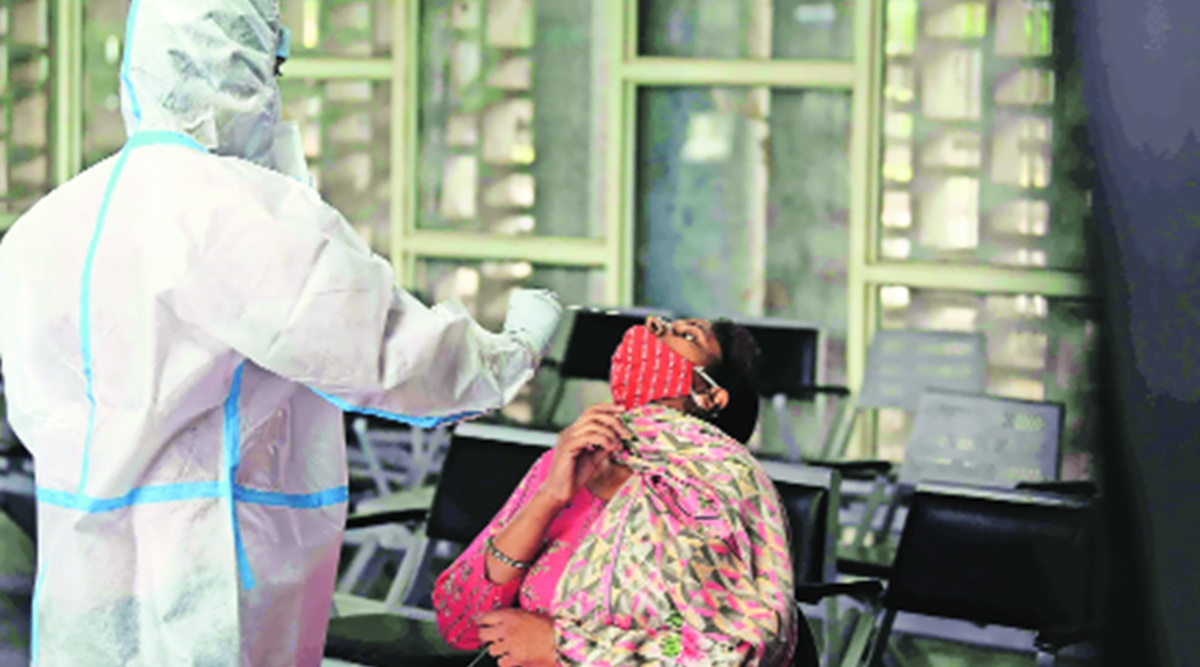 There were at least 28 villages which had also shown more than 10 per cent positivity rate during the Rapid Antigen Test drive. (Express File photo by Kamleshwar Singh)
There were at least 28 villages which had also shown more than 10 per cent positivity rate during the Rapid Antigen Test drive. (Express File photo by Kamleshwar Singh) THE COVID virus has begun to spread its tentacles in rural Panchkula, a survey has found, with authorities now scampering to step up surveillance and ramp up infrastructure to combat the rapid spread in the rural areas.
The administration conducted a survey in the second week of May, administering Rapid Antigen Tests (RAT) to villagers to determine the spread of the disease in the villages of Panchkula. The survey, conducted between May 9-May 12, has found a positivity rate as high as 36 per cent in rural Panchkula.
The district has identified 50 hotspot villages which had reported the highest number of positive cases. There were at least 28 villages which had also shown more than 10 per cent positivity rate during the Rapid Antigen Test drive conducted. These villages are now being screened by multi-departmental teams and all residents betraying any health problems are being retested for Covid. The highest postivity rate of 36.4 percent was reported from Toran village in Pinjore, Panchkula.
“Accessibility is not easy in the rural areas as compared to the urban ones. We have thus been trying to carry out testing in the rural areas extensively and have found a positivity rate of almost 6-7 per cent overall, with the highest positivity rate going up to 36 per cent. We are trying to isolate the patients who test positive and begin contract tracing. We are making isolation zones within their region to help bring down the positivity rate. If positive, a villager is immediately isolated at a village Covid care center. The positivity rate in rural areas presently is relatively less but spikes are being witnessed in certain hot spots. Efforts are being made to screen the population on mission mode and isolate positive cases at the earliest. This will help in restricting the spread,” said CMO Dr Jasjeet Kaur.
Of the 50 villages deemed as hotspots by the district, 24 were located in Kalka and Pinjore, 16 in Raipurrani and 10 in Barwala.
As many as 1743 people have tested positive from the rural belt of Panchkula between May 10- May 19 with an almost equal number, 1783 people, testing positive from the urban belt of the district during the same time. “While the first wave had barely touched the rural areas of the district, in the second wave the disease has spread rapidly in villages, with cases being reported now being quite high and at par with those of urban areas,” added Dr Kaur.
The district administration has taken drastic steps to mobilise several teams as they continue door-to-door surveys, and isolation of all positive patients to village Covid care centres. “We have several teams on the ground. Each team has four members — a regional ASHA worker, an Anganwadi worker, a voluntary teacher of JBT as well as a member of the block panchayat,” said Dr Sanjeev Goyal, senior medical officer at the Raipurrani CHC.
The teams go from door-to-door and search for ILI/SARI cases. If a person is found with symptoms, the team refers them to their Village Headquarter (HQ) team for further assessment.
The HQ team — comprising a healthcare official, a non-healthcare official, as well as a data entry operator — then checks the person’s SPO2, BP, Weight, temperature and administers them a RAT test. If the villager tests positive then they are either sent to the village Covid care center, or isolated at home with a Covid kit.
In apprehension of the third wave targeting the rural areas, the district has added a 30 bedded oxygen facility in government college of Kalka along with another 30 bedded oxygen facility in Raipurrani as they move down to raising infrastructure in the periphery areas. “There is an apprehension that next, rural areas which had remained out of harm as of yet might be affected equally if not more. We are rampantly raising our infrastructure to tackle it,” said Dr Kaur.
- The Indian Express website has been rated GREEN for its credibility and trustworthiness by Newsguard, a global service that rates news sources for their journalistic standards.

